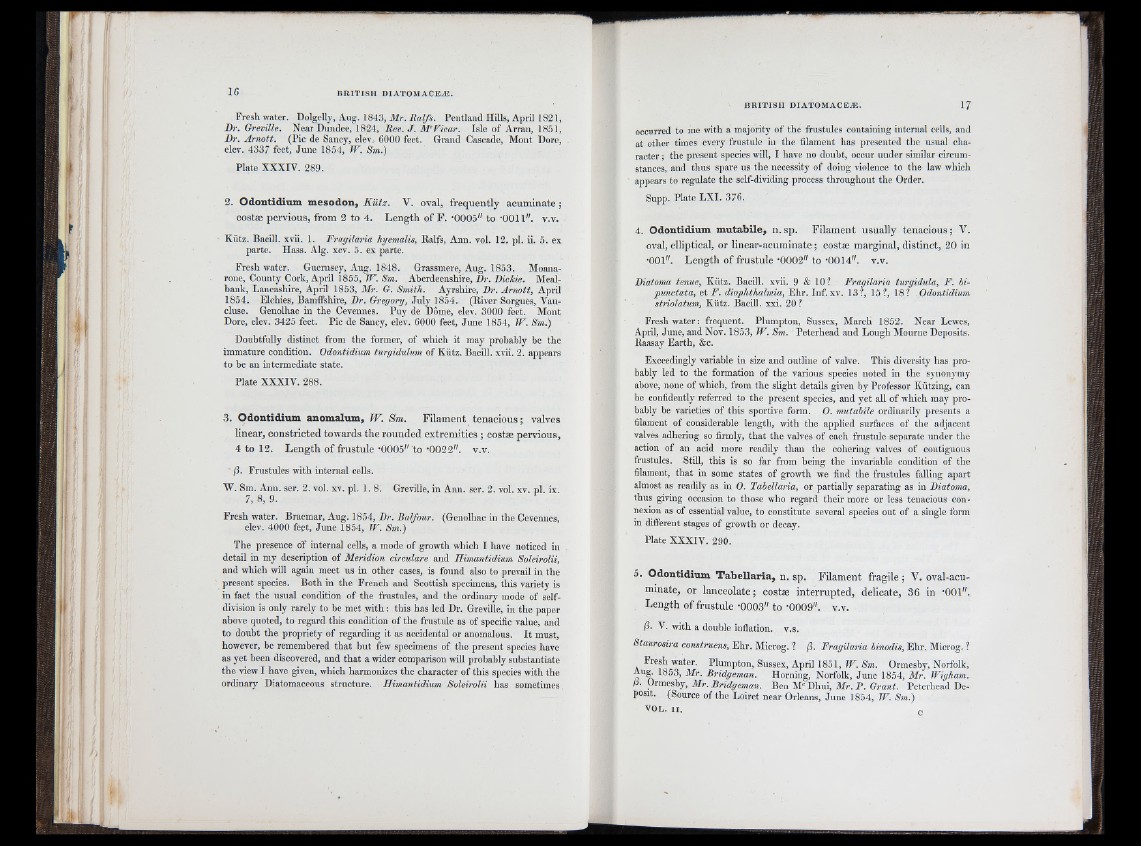
M
Fresh water. Dolgelly, Aug. 1843, Mr. Ralfs. Pentland Hills, April 1821,
Dc. Greville. Near Dundee, 1824, Rev. J. M’Ficar. Isle of Arran, 18,51,
Dr. Arnott. (Pic de Sancy, elev, COOO feet. Grand Cascade, Mont Dore,
elev. 4337 feet, June 1854, W. Sm.)
Plate XXXIV. 289.
2 . Odontidium mesodon, Kiitz. V. oval, frequently acuminate ;
costæ pervious, from 2 to 4. Length of F . -0005" t o -0011". v.v.
Kiitz. Bacill. xvii. 1. Fragilaria hyemalis, Ralfs, Ann. vol. 12. pi. ii. 5. ex
parte. Hass. Alg. xcv. 5. ex parte.
Freshwater. Guernsey, Aug. 1848. Grassmere, Aug. 1853. Moana-
rone. County Cork, April 1855, W. Sm. Aberdeenshire, Dr. Dickie. Meal-
bank, Lancashire, April 1853, Mr. G. Smith. Ayrshire, Dr. Arnott, April
1854. Elchies, Bamffshire, Dr. Gregory, July 1854. (River Sorgues, Vaucluse.
Genolhac in the Cevennes. Puy de Dôme, elev. 3000 feet. Mont
Dore, elev. 3425 feet. Pic de Sancy, elev. 6000 feet, June 1854, W. Sm.)
Doubtfully distinct from the former, of which it may probably be the
immature condition. Odontidium turgidulum of Kiitz. Bacill. xvii. 2. appears
to be an intermediate state.
Plate XXXIV. 288.
3. Odontidium anomalum, W. Sm. Filament tenacious; valves
linear, constricted tow'ards the rounded extremities ; costæ pervious,
4 to 12. Length of fru stu le -0005" t o -0 022 ". v.v.
/3. Frustules with internal cells.
W. Sm. Ann. ser. 2. vol. xv. pi. 1.8
7, 8, 9.
Greville, in Ann. ser. 2. vol. xv. pi. ix.
Fresh water. Braemar, Aug. 1854, Dr. Balfour. (Genolhac in the Cevennes,
elev. 4000 feet, June 1854, W. Sm.)
The presence of internal cells, a mode of growth which I have noticed in
detail in my description of Meridion circulare and Himantidium Soleirolii,
and which will again meet us in other cases, is found also to prevail in the
present species. Both in the French and Scottish specimens, this variety is
in fact the usual condition of the frustules, and the ordinary mode of selfdivision
is only rarely to be met with ; this has led Dr. Greville, in the paper
above quoted, to regard this condition of the frustule as of specific value, and
to doubt the propriety of regarding it as accidental or anomalous. It must,
however, be remembered that but few specimens of the present species have
as yet been discovered, and that a wider comparison will probably substantiate
the view I have given, which harmonizes the character of this species with the
ordinary Diatomaceous structure. Himantidium Soleirolii has sometimes
occurred to me with a majority of the frustules containing internal cells, and
at other times every frustule in the filament has presented the usual character
; the present species will, I have no doubt, occur under similar circumstances,
and thus spare us the necessity of doing violence to the law whicli
appears to regulate the self-dividing process throughout the Order.
Supp. Plate LXI. 376.
4 . Odontidium mutabile, n. sp. Filament usually tenacious ; V.
oval, elliptical, or linear-acuminate ; costæ marginal, distinct, 20 in
■001". Length of frustule ’0002" to '0014". v.v.
Diatoma tenue, Kütz. Bacill. xvii. 9 & 10? Fragilaria turgidula, F. bi-
punetata, et F. diophthalmia, Ehr. Inf. xv. 13?, 15?, 18? Odontidium
striolatum, Kütz. Bacill. xxi. 20 ?
Freshwater: frequent. Plumpton, Sussex, March 1852. Near Lewes,
April, June, and Nov. 1853, W. Sm. Peterhead and Lough Mourne Deposits.
Raasay Earth, &c.
Exceedingly variable in size and outline of valve. This diversity has probably
led to the formation of the various species noted in the synonymy
above, none of which, from the slight details given by Professor Kützing, can
be confidently referred to the present species, and yet all of which may probably
be varieties of this sportive form. 0. mutabile ordinarily presents a
filament of considerable length, with the applied surfaces of the adjacent
valves adhering so firmly, that the valves of each frustule separate under tlie
action of an acid more readily than the cohering valves of contiguous
frustules. Still, this is so far from being the invariable condition of the
filament, that in some states of growth we find the frustules falling apart
almost as readily as in O. Tabellaria, or partially separating as in Diatoma,
thus giving occasion to those who regard their more or less tenacious connexion
as of essential value, to constitute several species out of a single form
in different stages of growth or decay.
Plate XXXIV. 290.
5. Odontidium Tabellaria, n. sp. Filament fragile ; V. oval-acuminate,
or lanceolate; costæ interrupted, delicate, 36 in -OOl".
Length of frustule -0003" to -0009". v.v.
p. V. with a double inflation, v.s.
Staurosira construens, Ehr. Microg. ? ¡3. Fragilaria binodis, Ehr. Microg. ?
Fresh water. Plumpton, Sussex, April 1851, W. Sm. Ormesby, Norfolk,
Au^ 1853, Mr. Bridgeman. Horning, Norfolk, June 1854, Mr. Wigham.
li. Urmesby, Mr. Bridgeman. Ben M' Dhui, Mr. P. Grant. Peterhead Deposit.
(Source of the Loiret near Orleans, June 1854, IV. Sm.)
VOL. I I . „